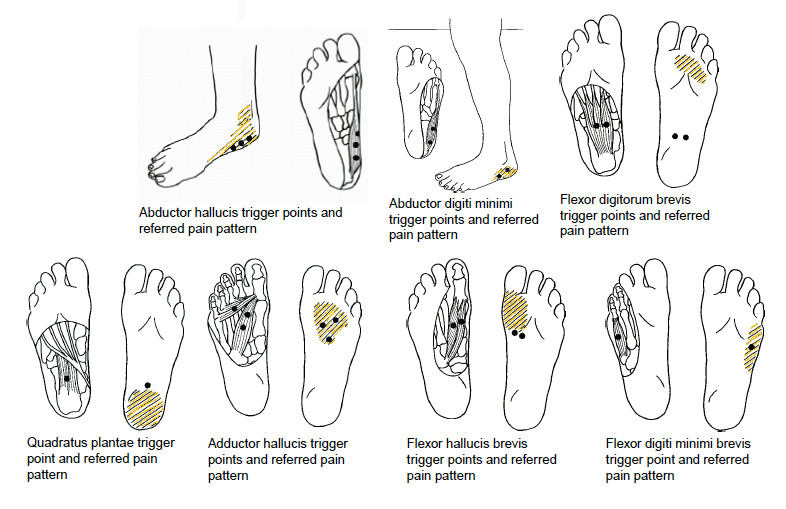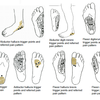UNCOVERING RELIEF FROM PAIN: MYOFASCIAL TRIGGER POINTS EXPLAINED

WHAT IS A TRIGGER POINT?
Considering the importance and pervasiveness of myofascial trigger points, the term trigger point is still largely unknown to the general public. Medical references in publications are finally beginning to give trigger points recognition and is usually defined as: Hyperirritable spot in muscle that is associated with a hypersensitive palpable nodule in a taut band of fascia. Or in simpler terms: It is a small grumpy spot within muscle tissue that typically causes discomfort upon pressure, therefore confirming your symptoms. Trigger points develop within the myofascia in specific places, where the motor nerve comes into the muscle to do its job (neuromuscular junction). Typically, are ranging in size from 2 to 10 millimetres, and can manifest in various locations within any skeletal muscle of the body. Trigger points are a natural occurrence within the body and can even be present in infants and children. The problem of trigger points begins with sudden muscle overload, sustained low-level isometric contractions, eccentric contraction, chronic muscle tension, gross trauma, overuse or sustained rapid movement.
TRIGGER POINTS CONFUSION: TRIGGER POINTS, ACUPUNCTURE POINTS AND PRESSURE POINTS
Acupuncture is a traditional Chinese medical practice that involves stimulating specific points on the body, typically by inserting thin needles through the skin. It is a method of treating disease, dysfunction, stress and pain and should not be confused with trigger point therapy, even though these points can coincide with trigger points.
A pressure point, also known as a pulse point, refers to the specific location over an artery where applying pressure helps halt the bleeding from a wound. The term is also used in reflexology and does not mean the same thing as trigger point. Reflexology is a holistic therapy that involves applying pressure to specific points on the hands, feet, or ears. These points are believed to correspond to different organs and systems in the body.
Myofascial trigger points are sensitive areas in muscle tissue, often associated with pain and tightness. They are believed to cause referred pain in other parts of the body and are addressed through manual therapy, such as massage or trigger point release.
Each of these points in the body is distinct in their purpose and application, with myofascial trigger points associated with muscle tension and pain, reflexology points connected to holistic wellness, and acupuncture points tied to the flow of energy in the body according to traditional Chinese medicine.
FOOT TRIGGER POINTS
Foot pain may be coming from intrinsic muscles (located in the foot) or it may not be coming from the feet themself. Sometimes the cause of the pain in the foot are also trigger points in calves and shins and knowing trigger points allows you to deal reliably with most kinds of pain in lower leg, ankles and feet.
When we are in vertical position, feet are quite literally the foundation for every activity and movement of the body. They are extremely complex, with a lot of small muscles, joints, bones and nerves intertwining in a small area. Good thing is that helping with the pain in that area does not require knowing (while it helps) all the terms and exact locations of this musculoskeletal system. It does help to understand, however, where the most common trigger points of the foot (and also lower leg) are.
DEALING WITH TPS
For a trigger point to be disbanded it is needed to release the actin filaments from the myosin heads, thereby allowing sarcomeres to lengthen. Most effective way to break the cycle is increasing blood circulation, leading to energy and oxygen supply boost of the affected muscle tissue. Massage of the TP may be the most non-invasive and risk free option for achieving all of that.
There are many advantages to self-applied massage: it is free, can be done at anytime and you have the best insight into pain and pressure used to treat the trigger point. The effectiveness of trigger point massage relies on your capacity to identify when your pain is actually referred pain and to trace it back to the specific trigger point causing it.
Self-massage guidelines
Avoid trying to force release. These points naturally release with regular, daily treatment, so practice patience. If available, utilize a tool to avoid strain on your hands (such as a Trigger pad for intrinsic feet trigger points). Apply pressure aiming for a moderate pain level. Engage with a trigger point multiple times throughout the day and incorporate it into your warm-up routine. Massage with brief, repeated strokes in a singular direction for optimal ergonomics.
Davies, C., & Davies, A. (n.d.). The Trigger Point Therapy Workbook: Your Self-Treatment Guide for Pain Relief. New Harbinger Publications.




